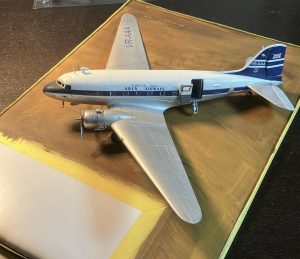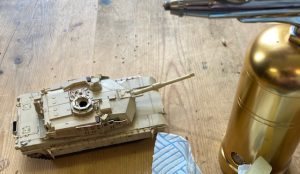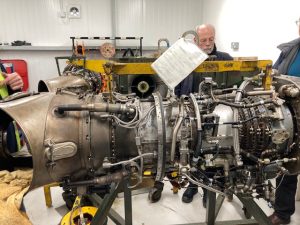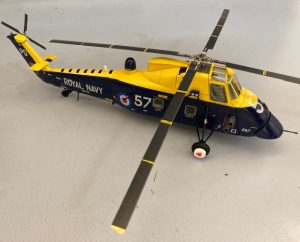 Deadlines were approaching, but as it was a fun project, I wasn’t feeling pressured but it would be a shame to miss the 6th of August challenge. I decided therefore to do the bulk colouring by using Humbrol spray cans to speed things up. Matt 30 green, 29 dark earth and 90 for the sky under surfaces. Using spray cans needs forethought and I’d already used the cans on the various sub assemblies. 90 covered the lower wing and undersides of the tail before being glued to the upper portions.
Deadlines were approaching, but as it was a fun project, I wasn’t feeling pressured but it would be a shame to miss the 6th of August challenge. I decided therefore to do the bulk colouring by using Humbrol spray cans to speed things up. Matt 30 green, 29 dark earth and 90 for the sky under surfaces. Using spray cans needs forethought and I’d already used the cans on the various sub assemblies. 90 covered the lower wing and undersides of the tail before being glued to the upper portions.
| I knew that I’d be colouring the whole underside yellow as the majority of captured Luftwaffe were done but some chipping would add to the finish, important for a model so large, so pre-painting with the sky colour was required (fig 18). Dark earth was applied to the 2 separate upper wings and the fuselage this meant a nice clean line was present when the parts were assembled. Irregular dabs of Maskol at areas that chipping might occur was added before airbrushing on Yellow – RLM04. |
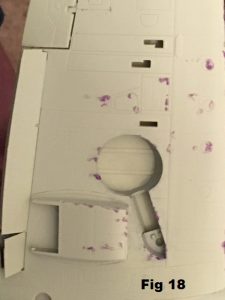 |
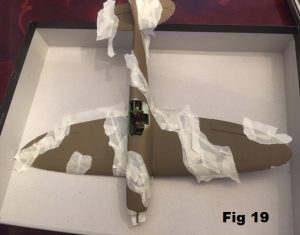 |
Spitfires have very recognizable camouflage schemes so time was taken to mask up the model using the Revell painting instructions as a guide along with re-colourised pictures of N3277. The cockpit was stuffed with foam to keep from overspray and then 30 Green sprayed carefully. I know using spray cans seems pretty hand-fisted but if carefully done and extensive masking used it can be successful (fig 19). Removal of the masking tape showed a decent job had been done. |
I looked at the original picture taken near Cherbourg to see where the Germans had over-painted the British markings. I then matched these with Luftwaffe black green via airbrush extending the cover up to include the ‘A’ that was originally left. Spray cans do go on heavier than an airbrush and the resultant colour is very flat so after leaving it in the sun for a day to harden the paint I gave it a spray of Tamiya gloss, again from a rattle can and left it to dry and off gas ready for the next stage.
| 6 Iron Crosses were added in the normal positions. They came from a Trumpeter kit and I must say how impressed I was with them. Strong but thin, they reacted well to Micro Set and Sol. I also applied the swastikas to the tail (fig 20). From the Revell Spitfire sheet I applied any British markings or warnings that were in positions that had not been over sprayed by the Germans. Oils were used then to add variation in tone and bring out the panel lines. I used Raw Umber on the underside as it seemed less overpowering to the yellow. But the upper surfaces needed a starker contrast so lamp black was used.( Fig 21 and 22.) |
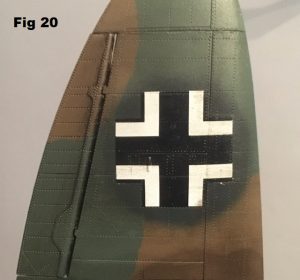 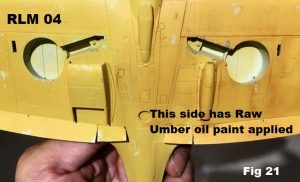 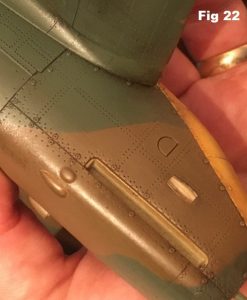 |
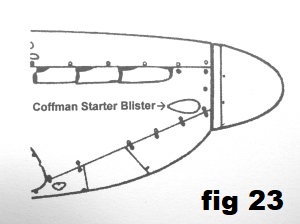 |
Concentrating on the nose area for a moment, I should note what attempts I’d made to backdate the Revell MKII to become a MKI. I’m certain this will not be a 100% corrected model as Spitfires are not my thing, but I did some basic research to identify the main changes. The obvious tear drop shaped bulge on the nose is the Coffman Starter blister (fig 23), not present on MK.I’s. Thankfully Revell had not made any location indent for this so it was easy to leave off. |
| I did note that for manual turning over of the Merlin in early Spitfires a small hole for the hand crank was present so I drilled one in the approximate place (fig 24 and 25). As mentioned all markings that were not over-painted by the Germans would be left visible and this new hole would require a warning notice. As it wasn’t on the kit decal sheet I used some leftover white decal then onto this some random lettering was applied. In real life this warning notice is for RAF personnel, suggesting they attach themselves to the landing gear to prevent being drawn into the propeller once it starts up. –Oops… Messy! |
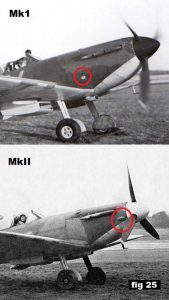 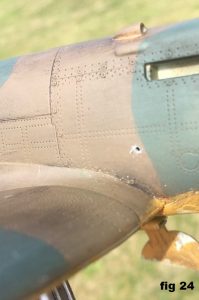 |
The instructions call out for some sanding of the spinner which was followed to remove unnecessary bulges and a different black was used for the spinner than the blades to add variety. Pictures of N3277 show a black spinner, and later test spitfires in Luftwaffe service seemed to keep the black cones so I stayed with that. Some scratching to show silver undercoat previously applied was done to age the spinner as by the time it was at the German test facility it would have been in service some time.
![]() Deadlines were approaching, but as it was a fun project, I wasn’t feeling pressured but it would be a shame to miss the 6th of August challenge. I decided therefore to do the bulk colouring by using Humbrol spray cans to speed things up. Matt 30 green, 29 dark earth and 90 for the sky under surfaces. Using spray cans needs forethought and I’d already used the cans on the various sub assemblies. 90 covered the lower wing and undersides of the tail before being glued to the upper portions.
Deadlines were approaching, but as it was a fun project, I wasn’t feeling pressured but it would be a shame to miss the 6th of August challenge. I decided therefore to do the bulk colouring by using Humbrol spray cans to speed things up. Matt 30 green, 29 dark earth and 90 for the sky under surfaces. Using spray cans needs forethought and I’d already used the cans on the various sub assemblies. 90 covered the lower wing and undersides of the tail before being glued to the upper portions. 







